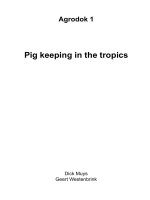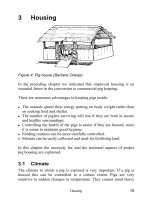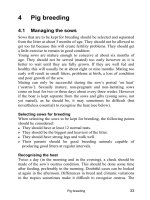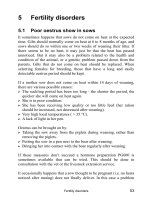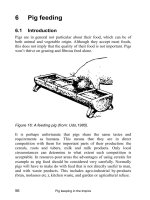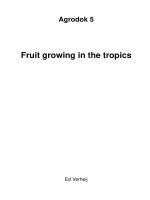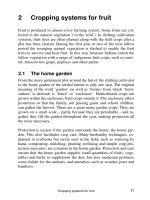Goat keeping in the tropics - Part 8 potx
Bạn đang xem bản rút gọn của tài liệu. Xem và tải ngay bản đầy đủ của tài liệu tại đây (218.48 KB, 16 trang )
Record keeping
81
8 Record keeping
Chapter 2 - Goat Breeding- and Chapter 3 - Raising and Selection-
already indicated that a good administration is essential to be able to
check the production of the business. Records of the production also
enable the farmer to select goats properly and thus improve the stock.
In the first place, for a good administration you must be able to recog-
nize your animals. If you have few goats and they have very distinct
markings, then you can recognize them by those markings (make a
sketch of each goat). If that is not the case, it is better to mark the
goats. Possibilities are: tattooing the ear with a number; making a pat-
tern of incisions in the ear which can be recognized; or attaching a
small plate with a number.
Servicing list and kidding records
To start with, you must make a servicing list (notebook) which you
keep in or near the stall and in which you record all data on kidding.
In that way you can easily see if the goats kid regularly and if the
number of kids born and weaned per goat is what you want. On the
basis of this information, you can track down problems and use the
differences between animals when selecting animals for breeding pur-
poses.
Table 4: Example of Servicing list, when servicing is not controlled
Goat No. or
name
Date giving
birth
Number of
kids
Sex of kids Number
weaned
Remarks
23 6 March 2 F + F 1 1 died of
diarrhoea
15 15 April 1 M 1
If you use a system of controlled servicing, then the times of servic-
ing, the billy-goat used and the expected date of kidding (date due)
can be written down. This information is useful for selecting good
billy-goats.
Goat keeping in the tropics
82
See the next page for an example of such a list.
Table 5: Example of Servicing list, when servicing is controlled
Date giving
birth
Goat
No.
Billy
goat
No.
Date
serviced
due real
Num-
ber of
kids
Sex of
kids
Number
weaned
Remarks
23 2 1st: 18/9
2nd: 8/10
4/3 6/3 2 F + F 1 1 died of
diarrhoea
15 3 2/11 12/4 15/4 1 M 1
Records on individual goats and billy goats
It is also a good idea to keep a separate record of each individual goat
and billy-goat. Those records should be kept at your home and you
must regularly update them using the servicing list.
Table 6: Example of an individual goat card
Goat no.: 14 date of birth: 15/8/96 Breed: Local
No. of Father: 3 No. of Mother: 9
Kids:
Litter No. Serviced by
billy goat no:
Date littering Litter size
M + F
Weaned
M + F
Remarks
1 2 20/7/97 1F 1F
2 3 30/4/98 2M 1M 1 died of
Diarrhoea
3
Diseases:
Remarks:
Keeping records enables you to follow the production per goat or billy
goat, also over a period of several years. You can compare the (billy)
goats with others in the herd. Using the information from your records
enables you to carry out a selection of (billy) goats.
On those cards you must also write down anything special, such as
changes in care (feed, pen) or diseases which occurred and their
treatment.
Record keeping
83
Table 7: Example of an individual billy-goat card
Billy goat no.: 2 date of birth: 27/7/ '96 Breed: Local
No. of Father: 3 No. of Mother: 8
Offspring:
Date ser-
viced
goat no: Date litter-
ing
Litter size
M + F
Weaned
M + F
Remarks
15/2/97 14 20/7/97 1F 1F
8/3/97 9 12/8/97 2F 2F 1 was sick
with Diar-
rhoea
Diseases:
Remarks:
Although it takes some time to set up and maintain a good administra-
tion, you will notice after a while that you do not feel lost if the pro-
duction suddenly drops or you want to sell animals. On the basis of
your administration, you can quickly find out what could be wrong or
which animals can best be replaced.
We wish you much success and good luck!
Goat keeping in the tropics
84
Appendix 1: Protein and energy
requirements and feed values
The protein and energy requirements are, unfortunately, expressed dif-
ferently in different countries.
? The energy requirements are commonly expressed by the Metabo-
lisable Energy (ME), expressed in Joules (MJ) (1 MegaJoule = 240
Kilo calories).
In America the ‘Total Digestible Nutrients’ (TDN) is used: the total
amount of dry matter which can be digested. In French countries
energy requirements are expressed as ‘forage units’ for Lactation or
for Meat production, resp. UFL and UFM.
1UFL = 7.2 MJ/kg; 1 UFM= 7.7 MJ/kg; 1.05 kg TDN = 15.9 MJ
ME
? The protein requirement is expressed in terms of the number of
grams of Digestible Crude Protein (DCP).
In table 8 and table 9 you find respectively the nutritional needs of
goats and the nutritional values of several feeds. Abbreviations used in
the tables: DM: dry matter in the feed, which is the remains after dry-
ing in an oven. DCP: Digestible Crude Protein ; CF: Crude Fibre
Table 8: Total energy and protein requirement and feed intake of
goats of different ages and weights
Weight of
goat (kg)
Growth
(g/day)
Energy need
(MJ/day)
Protein need
(g DP/day)
DM intake
(g/day)
DM intake
as % of
weight
10 50 3.99 23.2 414 4.1
100 5.75 33.5 597 6.0
20 50 5.50 32.0 571 2.9
100 7.26 42.3 755 3.8
150 9.03 52.6 938 4.7
30 50 6.82 39.8 709 2.4
100 8.58 50.1 983 3.0
150 10.35 60.3 1076 3.6
Appendix 1: Protein and energy requirements and feed values
85
Table 9: Dry matter content and feed value of several feeds (DM,
CF, DCP, ME: are explained on the page before this one)
Kind of feed DM (%) CF (%) DCP (g) ME (MJ) Quality
fodder
young grass 18 4 25 1.9 reasonable
old grass 54 20 0 1.9 poor
good hay 85 29 50 5.8 reasonable
rice straw 90 32 6 2.0 poor
cereals
maize 87 3 65 14.6 good
millet, sorghum 88 9 80 11.7 good
sorghum 87 2 55 13.3 good
rice, paddy 89 10 50 38.5 good
rice, husked 89 1 75 0.2 good
pulses
field beans 87 9 205 11.8 good
chick pea 91 11 150 12.5 good
cow pea 88 5 190 12.6 good
groundnut, with shell 94 18 190 20 good
groundnut, shelled 93 3 240 28.5 good
soya bean 89 6 300 17.3 good
oils seeds and by-pro-of oil preparation
cottonseed + husk 92 19 160 14.7 good
husked 94 3 300 20.6 good
cottonseed cake + husk 93 23 190 8.6 good
husked 92 12 350 11.0 good
sunflower seed + husk 92 27 120 17.8 good
husked 94 4 225 27.1 good
sunflower seed cake + husk 92 37 180 6.2 good
husked 94 16 355 12.1 good
groundnut cake + shell 91 22 285 9.5 good
shelled 92 6 455 13.8 good
soya flakes 91 7 410 14.0 good
coconut flakes 90 14 165 14.2 good
by-products of cereal processing
rice meal (3-10% husk) 90 9 715 12.6 good
barley draff, wet 23 4 140 2.5 reasonable
barley draff, dry 90 15 600 10.6 good
tuber and root crops
cassava root, dry 87 3 725 12.8 good
Goat keeping in the tropics
86
Example of calculating a ratio
Suppose you have a small goat of 10 kg which you want to grow
100 g a day. The feed which is available to you is cowpea and old
grass.
How much of this must you give the goat?
In table 8 you see that the daily requirement for the goat is 5.75 MJ
ME (energy) and 33.5 g DCP (protein). In table 9 you find the follow-
ing values for the energy (ME) and protein (DCP) content of old grass
and cowpea per kilogram of feed:
old grass 1.94 MJ ME 0 g DCP
cowpea 12.63 MJ ME 190 g DCP
Ensuring that there is sufficient protein in the ration is the most diffi-
cult part. In this case the cowpea provides the protein.
We give the goat daily 33.5/190 = 0.18 kg (180 g) cowpea. This ration
satisfies the protein requirement. At the same time, this amount of
cowpea daily provides energy: 0.176 x 12.63 = 2.22 MJ ME.
In your case you want to provide the remaining energy, equal to 3.53
MJ, using the grass. This means the goat must eat 3.53 / 1.94 = 1.8 kg
of grass daily. That is nearly 20 % of the body weight of the animal;
the goat will never manage to eat that every day! So you have to ac-
cept a slower growth or you will have to look for other energy-rich
feed (e.g.: molasses, groundnut waste, beer making wastes (draff)).
E.g. you can get hold of draff cheaply: dry the draff well in the sun.
In table 9 you find for dry draff: 10.6 MJ ME per kg.
This means the goat has to eat 3.53 / 10.6 = 0.3 kg of draff daily. This
amount the goat can manage. But it might be too expensive or not
available for a whole herd.
Try 250 g draff: this provides 0.25 x 10.6 = 2.65 MJ ME of the 3.53
MJ needed. Left to feed is: 3.53 - 2.65 = 0.9 MJ ME.
You can provide that by feeding the old grass: 0.9 / 1.94 = 0.5 kg
Note that the draff also provides protein: 0.25 kg x 600 = 150 g DCP.
Appendix 1: Protein and energy requirements and feed values
87
So you can leave the cow pea away and feed the goat 250 g dry draff
+ 500 g old grass = 750 g feed. This still is quite a lot for the goat, as a
young goat manages to eat 6% of its body weight per day.
For more information we advice you the book: ‘Improving goat pro-
duction in the tropics’ of Peacock, 1996. See the list of literature for
the details. Or write to Agromisa for help on calculating a ration.
Goat keeping in the tropics
88
Appendix 2: Hoof Care
If goats walk a lot on soft ground or are kept penned for long periods,
their hooves do not wear down enough. The hooves grow too long and
crooked and the goats cannot walk comfortably. Infections can also
occur. The extra growth must be removed in time you need to do that
about 4 to 6 times a year.
Figure 27: taking care of hooves
Appendix 2: Hoof Care
89
Figure 28: taking care of hooves
Goat keeping in the tropics
90
Appendix 3: A salt lick with local
materials
With a salt lick your animals will always have salt and minerals avail-
able, they will grow better and produce more milk. To make a salt lick
containing salt and other minerals you need: bones, salt and clay.
Figure 29: Source: Baobab Newsletter (Publ. by ALIN), No. 22.
Further reading
91
Further reading
Ayeni Ao, Bosman HG, Goat production systems in the humid trop-
ics., 1993, pp. 239, Pudoc Scientific, Wageningen. ISBN: 90-220-
1o78-3.
Chesworth J., Ruminant nutrition, Series: The Tropical Agricultu-
ralist, 1992, CTA/MacMillan, The Netherlands/UK. ISBN: 0-333570-
73-1
Devendra, C. and McLeroy, G.B., Goat and sheep production in the
tropics, 1982. Intermediate Tropical Agriculture Series, Longman
Group Ltd., Burnt Mill, Harlow, Essex, UK.
Forse, B., Where There Is No Vet, 1999. Animal health in developing
countries. Macmillan Education/CTA/OXFAM, U.K. ISBN: 0-85598-
409-0
Gall C, Goat breeds of the world., 1996, pp. 186, Margraf Verlag;
CTA, . ISBN: 3-8236-1251-4.
Indo-Swiss Goat Development and Fodder Production Project, Man-
ual for improved goat production: fodder resource development
for goats. Vol 3, 1993, pp. 65, ISGP, Uk.
Indo-Swiss Goat Development and Fodder Production Project, Ten
point programme for improved goat production: a guide-line. pp.
23 , ISGP,
ITDG and IIRR, Ethnoveterinary medicine in kenya: A field manual
of traditional nimal health practices. 1996, pp. 225, IT, Kenya.
ISBN: 9966-96-6-2-7.
Pagot J, Animal production in the tropics and sub-tropics., 1992,
pp. 517, Macmillan; CTA, Wageningen. ISBN: 0-333-53818-8.
Peacock C., Improving Goat production in the Tropics, 1996. A
manual for development workers, OXFAM (UK and Ireland) and
FARM-Africa, United Kingdom. ISBN 0-855982-69-1
Goat keeping in the tropics
92
Siefert H.S.H, Tropical animal health., 1996, pp. 548 pp, Kluwer
Academic Publishers, . ISBN: 0-7923-38219.
Steele. M., Goats. 1996, pp. 152 pp, Macmillan, Uk. ISBN: 0-333-
52309-1.
References
Aten, A., Faraday Innes, R. and Knew, E., Flaying and curing of
hides and skins as a rural industry, 1955. Third printing 1978; FAO
Animal Production and Health Series no.7, Rome.
Battaglia, R.A., Mayrose, V.B., Handbook of livestock management
techniques,1981. Burgess Publishing Company, 7108 Ohms Lane,
Minneapolis, MN 55435, USA.
Bayer. Handbook for farmers: stock diseases. Bayer, Leverkusen,
Germany.
Devendra, C. and Burns, M., Goat production in the tropics, 1983.
Commonwealth Agricultural Bureaux, UK.
Dorsman, W., Inleiding tot de parasitologie,1982. . Course syllabus,
Wageningen Agriculture University, Department of Animal Science,
Wageningen, the Netherlands.
Hall, T.B., Diseases and parasites of livestock in the tropics, 1985.
2nd ed. Intermediate Tropical Agriculture Series; Longman Group
Ltd., Burnt Mill, Harlow, Essex, UK.
Ketelaars, J.J.M.H. and Tolkamp, B.J., Towards a new theory of feed
intake regulation in ruminants,1991. Doctoral thesis, Agricultural
University Wageningen.
Leng R.A., Drought feeding strategies: Theory and practice, 1992,
Penambul Books, Australia. ISBN 0-958829-00-4
Mann, I., Animal by-products: processing and utilization, 1962.
Third Printing 1978, FAO Animal Production and Health Series no.9.
FAO, Rome.
Further reading
93
Merck, The merck veterinary manual, 1986. 6th ed. Rahway, NJ,
USA.
Morand-Fehr P., Goat Nutrition, 1991, EAAP Publication No 46,
FAO/EAAP/CIHEAM/CTA, the Netherlands. ISBN 90-22010-09-0
Thienpont, D., Rochette, F., Vanparijs, O.F.J., Diagnose van vermi-
nose door coprologisch onderzoek, 1979. Janssen Research Founda-
tion, Beerse, Belgium.
Vendrig, A.A.A., Gezonde geiten: diergeneeskundige aspecten van
de geit, 1984. Groene Reeks, Terra, Zutphen, the Netherlands.
Williamson G., Payne, W.J.A., An introduction to animal hus-
bandry in the tropics, 1987, Tropical agriculture series, Longman
Scientific & Technical, UK. ISBN 0-582468-13-2
Goat keeping in the tropics
94
Useful addresses
e(kika) de la gaza, Institute for goat research programs
The mission of the E (Kika) de la Garza Institute for Goat Research is
to develop and transfer enhanced goat production system technolo-
gies, with impacts at local, state, regional, national, and international
levels. The Institute strives to fulfill this mission through excellence in
a results-driven, highly productive research program; an effective, cli-
ent-oriented extension approach; and dynamic international activities
that stress development and human capacity building.
Langston university: P.O.Box 730, Langston, USA
Telephone: (1) 405-466-3836;
E-mail:; web-site: www.luresext.edu/goats/
Zodiac, Animal science department, WUR
Zodiac; is the Animal science of the Wageningen University and re-
search centre.The core-business of the department is scientific educa-
tion and research in the area of animal sciences. The department aims
to contribute to a sustainable animal husbandry, aquaculture and fish-
eries.
Marijkeweg 40, , 6700 PG, Wageningen, NL
Telephone: +31 317 48 39 52; Fax: ,+31317483962
E-mail:; web-site: www.zod.wau.nl/
FAO, Food and Agricultural Organization of the United Nations
FAO Animal production and helath division : Mission is to clarify and
facilitate the role of the livestock sub-sector in poverty reduction, im-
proved food security, improved food safety, as well as in safe trade in
livestock and Animal products while safeguarding environmental sus-
tainability and biodiversity.
Viale delle terme di carcalla 100, Rome, Italy
Telephone: +39 06 570 533 71; Fax: +31 06 570 55749
E-mail:;
web-site: www.fao.org/ag/AGA/AGAP/LPS
Useful addresses
95
ILRI, International Livestock Research Institute
ILRI helps the world’s poor people build and protect their livestock-
based assets so that these, not poverty, are passed on to the next gen-
eration
P.BOX 5689, Addis Ababa, Ethiopia
Telephone: 251 14 63 215; Fax: 251 1 461 252
E-mail:; web-site: www.ilri.cgiar.org
International Goat Association
Publishes The Small Ruminant Research Journal
Rutland, MA01543, Rutland, USA
Telephone: 15088866729
British Goat society
Publishes a monthly journal for members.
34-36 Fore Street, Bovey Tracey, Newton Abbot, Devon TQ139 AD,
Devon, UK
Fax: +44 162 6833168
Dairy goat journal
Publishes monthly newspaper obtained by subscriptions
W2997, Markert Rd, Helenville, W153137, Helenville, Uk
ITDG East Africa, Intermediate Technology Development group
A newsletter for rural development in dry Africa
P.O.Box 39493, Nairobi, Kenya
Telephone: +254 2446243/442108
E-mail:;
Baobab newsletter
C.P.3 Dakar-Fann, Dakar, Senegal
Telephone: +22118251808
E-mail:baobab@sonatel,senet.net;
DIO, Foundation for veterinary Medicine for development coopera-
tion.
The DIO foundation gives support and advice in the field of animal
health and production to the poorer people of the world, irrespective
of country of origin, beliefs or political interests. The main tool in our
Goat keeping in the tropics
96
efforts is the Veterinairy Information Service (V.I.S.), which is free to
our target group. Furthermore, we try to help by giving advice on
animal diseases and other veterinary issues. Secondly we want to
promote awareness in The Netherlands of the importance of animal
health in development co-operation. Our motto is: healthy animals,
healthy people.
Yalelaan 17, 3584 CL, De Uithof, Utrecht, The Netherlands
Telephone: +31 (0)30-2532032; Fax:+31(0)2532050
E-mail:; web-site: www.dio.nl
PTC+, Practical Training Centre
PTC+ is an international training institute, which focuses on all the
links in the production chain on plant and animal commodities, (agri-
cultural) technology, (food) technology and natural areas.
Training programmes are practice-oriented and mix theory with prac-
tical classes. PTC+ offers “open entry” programmes, “tailor-made”
programmes and consultancy. Programmes are offered in the Nether-
lands and/or at location.
It is the policy of PTC+ to search for partnerships and co-operation
programmes with national and international institutions abroad.
PO.BOX 85, 9062 ZL, Oenkerk, The Netherlands
Telephone: +31 582543700; Fax: +31 582543701
E-mail:; web-site: www.ptcpus.com
National Goat Handbook – University of Maryland,
Maryland Small Ruminant Page


